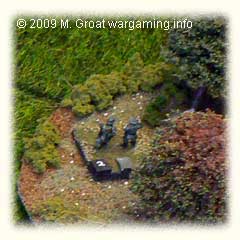
Date Played: 04 April 2009 11.00am BST (04 April 10.00am GMT); 1230 WCFD Game Time.
Game Report by Martin Groat.
Each side has released their respective propaganda, published with this report (see below), and provided here is also the third “neutral” report, and a discussion of the terrain and scenario.
The Germans were given the task of defending 2 pillboxes sitting on a hill in the North West corner of the board. They commanded a road to the West, off board. This road was of some significance to the games that followed and the Allied forces were ordered to seize the Pill Boxes so as to secure the road.
The pillboxes were therefore directed away from the board itself. The Germans consisted of 2 under strength companies of 2 platoons each, each platoon consisting of 2 squads. Each company had an HMG, there was one 8cm mortar, with 20 FMs and a Pak40. The troops were Regular status but only for 60 mins on the chess clock, after that they would fight on for another 40 mins but as Green status. After those 40 mins they would withdraw. The Germans could deploy anywhere on the board except the Allied deployment zone.
The Allies entered on the South East corner of the board, and were ordered to advance in 3 waves. Each wave would be a company. The waves were given, respectively, 40, 35, and 30 minutes on the chess clock to get as far as they could. Upon the dropping of the flag on the clock the wave would “go to ground” and would not advance further, although they could fire in support of the succeeding wave(s), and move backwards if they wanted. The Allies consisted of 3 companies; each company consisting of 3 platoons of 3 squads & a PC, plus a CC, 82mm mortar with 12 FMs, and an HMG. There was also a BC in overall command.
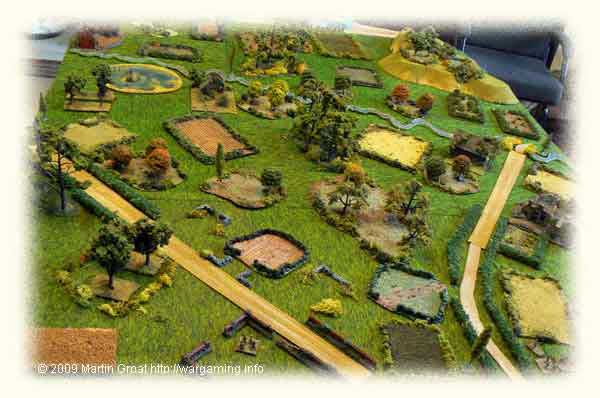
Terrain
Very sensibly Lloyd simply specified the position of the pillboxes, the hill upon which they stood, and the Allied entry point. It was set in countryside with isolated buildings. There had to be enough cover to allow the Allies to deploy each wave in turn without getting shot to bits. It was left to us to do the rest and so as I hope the photos will show and as is our habit the terrain was fairly cluttered with out of season fields, woods, hedges and a stream. The stream roughly divided the board between north and south. We also included a couple of roads and 4 buildings.
The Germans did not know the size of the Allied forces, nor initially, did they know of the “wave” mechanism. As a consequence of the preceding games the Germans did not have much time to deploy so only 2 squads were deployed hidden, and there was no wire or other impediment.
Immediately before the game started the Germans received a bulletin from the Front stating they were to be joined by a StuG III, with immediate effect and the Allies were notified they were to receive 2 Sherman tanks from Game 4 (having originally come from Game 1, and not been called upon in either game), to join the 2nd Wave.
The Game
The following 3 reports give a flavour of how it went.
The Allied View
Comrade Commissar, I write to report another spectacular victory against the Fascist Forces and we Hungarian Communists hope you will pass this on to Moscow to see how the Revolution’s Glorious Allies are striving to support the People’s Revolution.
We faced a number of German Platoons, who although had reduced numbers, fought with desperation. At least 2 squads were hidden and we found that contrary to our information they were reinforced by a StuG IIIG that appeared as we readied to commence our assault.
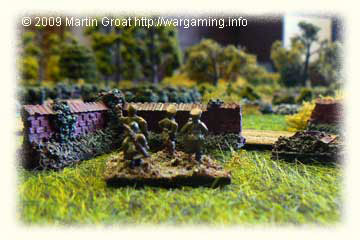
As ordered we divided into 3 waves – 1 company each with support – and although the boys were tired and hungry, they were raring to go. Our job was to get the pillboxes on the hill to the north and so help secure a road that ran to the west.
The first wave started with a successful attack up the left flank, over the stream that divided the area and got well onto the Fascists flank. Unfortunately there was a bit of over enthusiasm as a result of which we lost a number of our boys and were more or less pushed back to the start line, with the remaining troops losing heavily.
As the second wave formed up 2 Sherman tanks that had been sent to us from an earlier successful operation joined us and so they advanced towards the centre closely supported by the infantry. Again there was another sortie along the left flank which nearly reached the hill but ran out of time. In the centre we killed a number of fascists, reducing their numbers and they gradually moved back over the stream, before our boys, now very worn out went to ground. Unfortunately this wave lost it’s mortar support earlier on as the FO ventured too far and was seized by the fascists in a cowardly snatch and grab sortie.
The Shermans returned to the start line, the third wave advanced but this time 2 of the platoons went up the road on the right flank, crossed the stream supported by one Sherman. The Fascists were very thinly spread and could not oppose the glorious advance and taking of the pill boxes. Even greater glory followed as the other Sherman knocked out the StuG as it tried to pull back and attack our boys moving onto the Pill box.
Rumours that this might have been a Pyrrhic victory are of course grossly exaggerated and all we would expect from the Fascist Gutter Press.
The German View
With only two reduced companies of infantry supported by a single heavy machine gun, one anti-tank gun and a single StuG the defenders followed their orders to defend to the last bullet. Despite overwhelming odds these hero’s inflicted a heavy cost on the enemy.
The initial attack by the allied forces managed to force a way down the right flank of the gallant defenders and had it not been for the heroic actions of one squad held in the rear then the allies would have reached their objective early in the day. This squad managed not only to defend their position but also inflicted heavy losses on the attacking force. Their colleagues were then able to launch a counter attack on the remaining attackers, decimating all but a few.
It was, at this point, that a second allied wave arrived with armoured support which managed to force the heroic defenders back to a second line of defence. It appears at this point that our hero’s were let down by ill fortune and the careless individual that left the Panzerfausts back at the base! Despite this and heavy losses that the enemy armour inflicted, the defenders managed to hold their own, giving ground at great cost to the enemy.
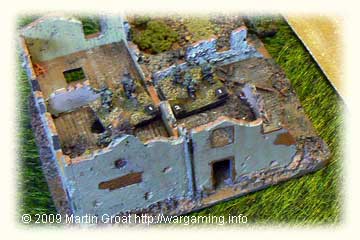
A notable incident during this action, was the capture of an enemy forward observer who had strayed a little too far in advance of his units. A single section was able to advance to his position and remove this threat before withdrawing to their former position; their action can only have saved many early casualties and made the attackers job more difficult.
Just as the situation looked unattainable the enemies attack ground to a halt and they dug in in the positions they had occupied. Their armour seemingly seemed to withdraw. This allowed the remaining German units the chance to rally themselves and withdraw to new defensive positions.
Unfortunately it seems that the enemy has endless numbers of troops available, as it was at this point that the armour returned and a third wave of infantry appeared. Our heroic defenders were by this point reduced to less than a third of their original number and despite a gallant attempt to defend their position with further losses taken including the loss of their armoured support, they were outflanked and their positions were taken. From the original defending unit a single squad and the forward observer were the only survivors. The Company Commanders were however, able to walk away from the field of honour, and seemingly chose not to join their men in an heroic death for the Fatherland. They have been given new assignments in special service detachments (Penal) on the Eastern Front.
Overall (Neutral?) View
The Germans deployed initially mainly on the Allied side of the stream and so started laying down fire as soon as the Allies commenced their opening assault of 2 platoons with support on the left flank. The 2 hidden squads were quickly revealed as the Allied assault went rapidly up board to cross the stream. Having successfully taken one of the outbuildings on the German side of the stream and eliminating the defenders the elements of the 2 Allied platoons then started an advance towards the pill boxes (and therefore also behind the rear of the defending Germans). Confidently expecting to overwhelm a single suppressed German stand in an adjoining field the Allies were dumbfounded when a spectacularly good die throw by the Germans won the melee against a spectacularly bad die throw by the Allies. The Germans, now with the initiative, rapidly regrouped and went on the offensive towards the remaining Allied Platoon on the right flank, and eventually outflanked them. End of Allied first wave and with a small amount of chess clock time left the Germans moved back to consolidate their positions before the second wave started. No benefit to the Allies at all save that 2 German squads were lost.
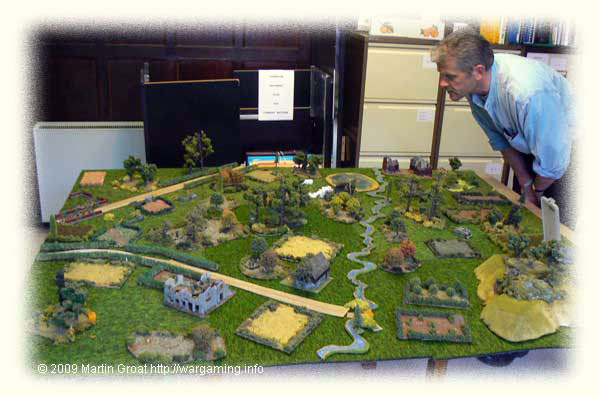
The second wave went in supported by the 2 Shermans. Again there was an advance up left flank whilst the Shermans, backed up by a platoon on the right flank went up the centre. An overly adventurous mortar FO was taken by the Germans early on thus depriving the Allies of their mortar. The first wave’s mortar had been lost already. The StuG was much in evidence although was forced to dodge the Shermans, and managed to halt one platoon’s progress as it went up the centre. This time the Allies were able to get most of their platoons up to the stream with one platoon deep in the German rear but still could not launch any serious assault on the pillboxes themselves. The Germans took further casualties and were now looking seriously depleted as the chess clock flag fell and the second Allied wave went to ground…
The Shermans returned to the start line to await orders from the CC of the 3rd wave. The Allied second wave was scattered across the board and took no further part in the action as the Germans pulled back again. During the early part of this phase the Germans reverted to Green status. This time one Sherman, supported by one platoon, went up the centre once more whilst the other, with the rest of the wave, went up the road on the left flank and fairly swiftly forded the stream whilst the infantry platoons commenced their assault upon the pillboxes themselves. The Germans, by now heavily outnumbered attempted to retake them but were destroyed. The StuG, whilst moving back towards the hill upon which the Pillboxes were situated took a rear shot from the centre-deployed Sherman and disintegrated. With minutes to go the Allies mopped up any effective remaining opposition.
Although the Allies had won they had suffered significant casualties – especially with the first wave having been destroyed – and it was not until the latter part of the third wave they finally seized the pillboxes. The Germans, despite their small number had held up a significantly larger force and Lloyd calculated, after taking all of this into account, that it was a -5 victory points win for the Allies.
Comments
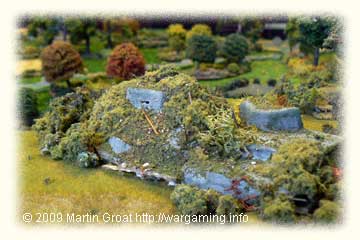
We had used chess clocks before and like them but only to bring a game to an end; i.e. a deadline. Lloyd in designing this scenario had used them to the full. The going to ground of each wave and the change of German status reflected the tiredness and low morale of each side at the outset of the game. We had created a fairly dense terrain which gave the Germans plenty of cover but also reduced the effectiveness of the PAK 40.
We had not used the wave idea before and most certainly would do so again. The practicalities of the day worked out fine for us and getting bulletins from the front whilst we were playing added a nice touch.
Overall it was a great idea and if one was run again we would be up for it. I can see that running a world wide campaign in this format is a huge amount of work for one man and if it is done again thought needs to be given to dividing the labour-perhaps a co-ordinator for each region, with regional results being passed onto the next region.
Once again – Thanks Lloyd!!
The Players & Location
Allies: Martin Groat & Sandro Gromen Hayes.
Germans: Andy Joyce & Bob Davison.
Location: East Grinstead, West Sussex, UK.
One thought on “WCFD Game 9”